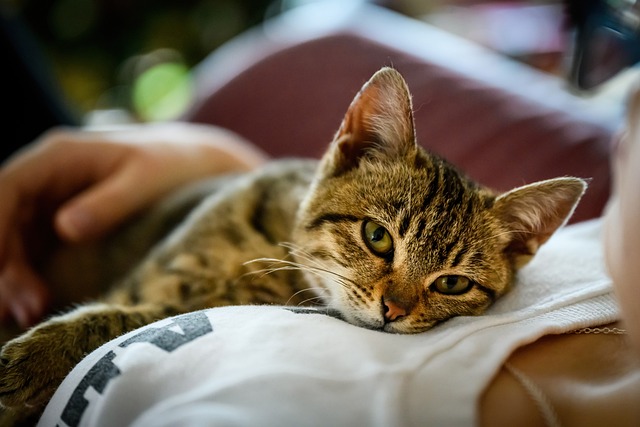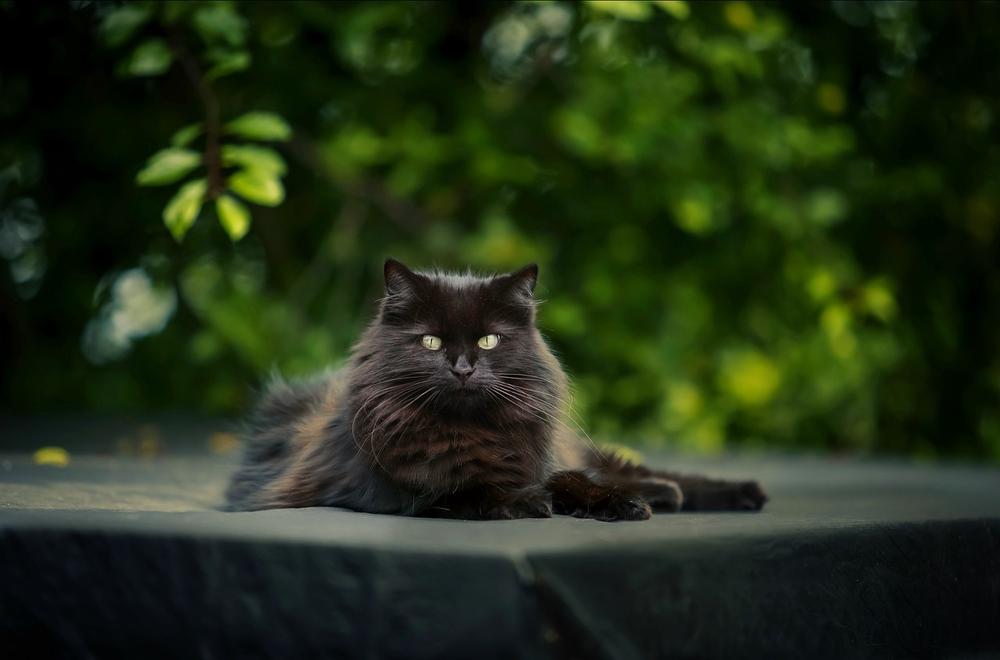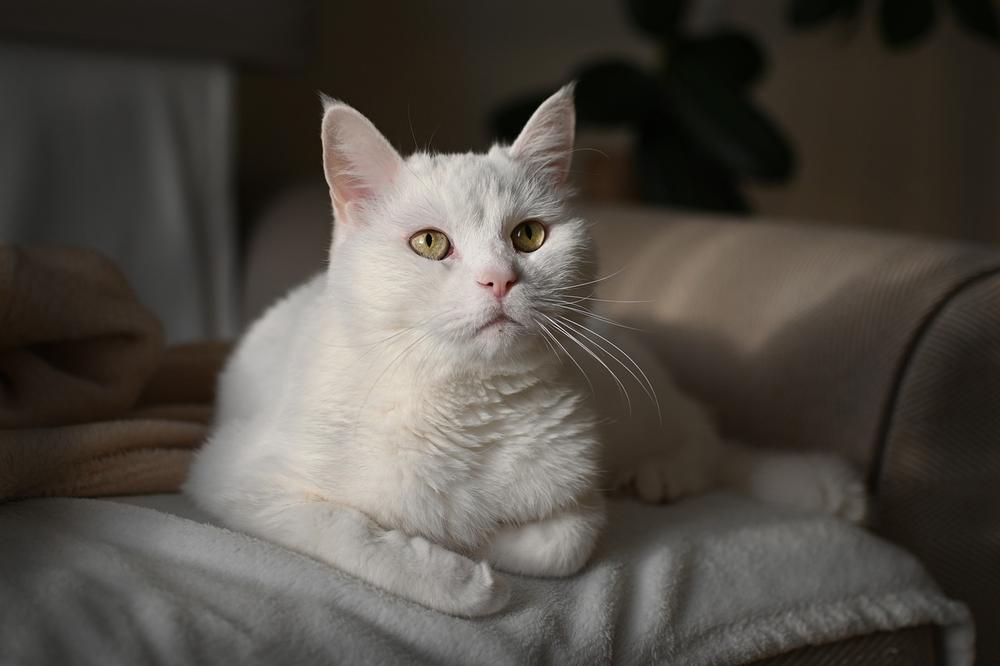This Is Why Your Cat Is So DESPERATE for Attention

Are you tired of feeling like your cat is constantly vying for your attention?
Do you find yourself questioning if your furry friend is secretly plotting to take over your life? 😼
Believe me, I've been there.
Those desperate cries for attention can make even the most patient of cat owners want to run for the hills.
But fear not, my frustrated friend.
In this blog post, we'll delve into the mysterious world of feline behavior and uncover just why your cat seems so desperate for your undivided attention.
So grab a cup of coffee, put those feet up, and let's unlock the secrets together.
Why Cats Seek Attention: Understanding the Reasons Behind the Behavior
Cats crave attention to bond with their owners
Cats are captivating creatures, don't you think?
They have this enigmatic charm that draws us in and makes us want to shower them with love and attention.
But ever wondered why these furry companions seek attention from us?
Well, one reason is that they use attention-seeking behavior as a way to form stronger bonds with their owners.
When they rub against your legs, hop onto your lap, or purr endlessly, they are letting you know that they want to connect with you on a deeper level.
It's like they're saying, "Hey, I really like you, and I want to be close to you!"
And here's the amazing part – paying attention to your cat actually strengthens the bond between us humans and our feline friends.
Spending quality time together, snuggling up, playing, and giving them attention when they ask for it can bring both of us immense joy and make us feel even closer.
Attention-seeking behavior may indicate underlying issues
Now, here's something crucial to please bear in mind:
While seeking attention is generally normal behavior for cats, it can also be a warning sign indicating something more profound going on with your kitty.
That's right – excessive attention-seeking behavior in cats might signal stress, fear, or anxiety. It's your cat's way of reaching out and asking for help, telling you that something isn't quite right in their small world.

So, pay attention (pun intended) to any other signs your cat may be showing. Are they avoiding certain areas of the house?
Have they stopped eating or grooming themselves?
These could be indications that their attention-seeking is more than just about bonding; it could be a cry for assistance.
Understanding your cat's attention-seeking behavior is crucial
To address attention-seeking behavior in cats effectively, we must first understand their individual needs and motivations.
What triggers this behavior in your precious feline?
Is it simply their desire to deepen the bond with you, or is there an underlying issue at play?
By understanding why your cat seeks attention, you can customize your approach and find suitable solutions.
For some cats, a little extra love and attention might be all they need.
However, for those dealing with anxiety or fear, you should consult with a veterinarian or animal behaviorist to ensure their well-being.
Each cat is unique, and figuring out what works best for them is the key.
So, observe, listen, and respond accordingly to your cat's attention-seeking ways.
Because, in the end, a happy cat means a happy owner!
Main points I'll expand upon further down this article:
- Cats may display attention-seeking behaviors such as pawing, meowing, and walking between legs.
- Excessive attention-seeking could indicate underlying issues or boredom.
- Introduce more activity and playtime to combat boredom and reduce attention-seeking.
- Environmental enrichment, like cat trees and toys, can alleviate stress and eliminate attention-seeking behaviors.
- Consider adding another cat gradually to provide companionship if loneliness is a factor.
- Offer appropriate scratching surfaces to discourage furniture scratching.
- Consistency in feeding, playtime, and routine can reduce attention-seeking behavior.
- Use positive reinforcement, counter conditioning, and clicker training to teach appropriate behaviors.
- Ignore unwanted behavior to avoid reinforcing attention-seeking.
- Seek veterinary attention if there are noticeable changes in behavior or excessive appetite.
And now, let's dive into some common signs of attention-seeking behavior in cats and how to address them effectively.
Signs of Attention-Seeking Behavior in Cats
Cats can be quite dramatic when it comes to seeking attention. They have various ways of making sure they catch your eye.
Pay close attention to these 10 signs:
- If your cat is constantly tapping at you or furniture, it's their way of saying, "Hey, how about some attention?"
- Cats have a knack for circling around your legs, especially when they want you to notice them.
- Chewing on stuff that isn't food, like cords or plastic, is basically a desperate plea for your attention.
- You know those times when you're working on your computer and suddenly there's a cat parade across your keyboard? Yep, total attention-grabbing move.
- Meowing non-stop? That means your feline friend craves your attention and wants some interaction, pronto.
- Ever had your cat magically appear on the countertop out of nowhere? Yeah, they do that because they want you to give them some love and affection.
- Knocking things off shelves or counters may seem mischievous, but it's really just a sneaky way of saying, "Pay attention to me!"
- Biting isn't always a sign of aggression; sometimes, it's just your cat's desperate attempt to get noticed by sinking their teeth into your skin.
- Don't be surprised if your cat starts swiping personal items and running away with them. It's just another way they're screaming, "Look at me, look at me!"
- Lastly, watch out for the leg-weaving maneuver. Your cat will zigzag between your legs to ensure they have your undivided attention.
While it's natural for cats to seek attention, an excessive need for it could indicate deeper issues.
Giving your furry buddy proper attention and mental stimulation can help reduce these attention-seeking antics.
So, make sure you give your favorite feline the love it deserves! 😺

So, now that we've covered the signs of attention-seeking behavior in cats, I want to address another common issue that cat owners often face.
Have you ever found yourself wondering why your cat is suddenly ignoring you? It can be quite perplexing and even a bit upsetting.
But don't worry, I've got you covered! If you're curious to find out possible reasons for this behavior, I highly recommend checking out my article on Why Is My Cat Ignoring Me All of a Sudden.
It's a useful resource that delves deeper into this topic and provides valuable insights.
Trust me, you don't want to miss it!
The Importance of Providing Enrichment for Your Cat
Providing enrichment for your cat is crucial to their overall well-being. Here are some ways you can do it:
- Rotate toys: Keep a variety of toys on hand and switch them up regularly to prevent boredom.
- Puzzle feeders: These interactive toys make mealtime more challenging and mentally stimulating.
- Indoor hunting: Hide treats or small toys around the house for your cat to find, mimicking their natural hunting instincts.
- Cat trees and shelves: Provide vertical spaces for climbing and perching, giving your cat different vantage points in their environment.
- Window perches: Allow your cat to watch birds and outdoor activities, providing visual stimulation.
- Cardboard boxes: Cats love hiding and playing in boxes, so save a few for them to explore and hide in.
- Outdoor access: If it's safe and appropriate for your cat, create an enclosed patio area where they can experience nature while being protected.
- Scratching posts: Offer multiple scratching surfaces to satisfy their instinct to scratch and keep their claws healthy.
- Scent enrichment: Use cat-safe herbs like catnip, valerian, or silver vine to stimulate your cat's senses.
- Playtime: Spend quality time engaging in interactive play sessions with your cat using wand toys, laser pointers, or feather teasers.
By enhancing your cat's surroundings and offering a range of mental and physical activities, you can successfully diminish attention-seeking tendencies and promote a more contented and well-being feline life.

And now, let me share with you some practical strategies that I find effective in addressing excessive attention-seeking behavior in cats!
Establishing a Routine for Your Cat's Attention and Playtime
Here's how you can establish a routine for your cat's attention and playtime:
- You need to set specific times every day for interactive play sessions. This way, your cat will get the mental and physical stimulation it needs.
- Give your cat plenty of attention and playtime, especially if there are no health issues. This will prevent boredom and keep your furry friend happy.
- Get suitable scratching surfaces like different types of scratching posts. This will stop them from wrecking your furniture or carpets.
- Schedule special times to play, cuddle on your lap, and give your cat some affection. It satisfies their attention-seeking behavior and makes them feel more at ease in their surroundings.
- Instead of feeding your cat one big meal, offer several small meals throughout the day. This not only reduces attention-seeking behavior but also provides mental stimulation.
Consistency is crucial for meeting your cat's needs for attention and mental stimulation.
By following these tips, you'll create a routine that keeps your cat content and engaged.
And now, let's explore some effective strategies for discouraging any undesired behaviors and redirecting your cat's attention towards more appropriate outlets!
Setting Boundaries and Teaching Your Cat Appropriate Behavior
When it comes to setting boundaries and teaching your cat appropriate behavior, there are some key strategies you can use:
- Consistently discourage undesired behaviors by redirecting your cat's focus onto toys or scratching posts.
- Clicker training can be effective in teaching your cat appropriate behavior, such as sitting on a mat instead of pawing at you.
- Counter conditioning can help change specific behaviors, like teaching your cat to sit instead of jumping into a chair.
- When addressing unwanted behavior, wait until your cat stops before giving them attention. Punishment is less effective than ignoring.
- Negative reinforcement, like blowing air, can be used to discourage certain behaviors. Correction involves unpleasant consequences, like yelling.
- It's important not to reinforce attention-seeking behaviors by scolding or petting. Offering food to stop unwanted behavior can reinforce it.
- Reprimanding your cat for attention-seeking behavior can damage the bond between you. Instead, ignore their demands and only give attention when they have calmed down.
- While destructive behaviors shouldn't be accepted, intervention should be done calmly and without emotion.
Listen closely, because this is the secret sauce: By implementing these strategies, you can begin to address your cat's attention-seeking behavior. But keep reading, because further down the blog post, I'll discuss addressing underlying medical issues that may be causing this behavior.
And let's be honest, understanding why your cat seeks excessive attention is just the beginning.
But what if there were simple and proven strategies that could help address this behavior?
Well, lucky for you, the next section will reveal some effective techniques to encourage independent play and alter their response to certain stimuli.
Are you ready to take the first step towards a calmer and more contented feline companion?
Using Positive Reinforcement to Encourage Independent Play
To encourage your cat to engage in independent play, try these 10 tips:
- Use treats and praise as rewards for independent play.
- Provide a variety of toys and play options.
- Set aside dedicated playtime each day.
- Offer interactive toys that stimulate their natural hunting instincts.
- Rotate toys regularly to keep them interesting.
- Find out what type of play your cat enjoys most.
- Use positive reinforcement to shape desired behavior.
- Be patient and allow your cat to explore at their own pace.
- Create an enriched environment with climbing structures and hiding spots.
- Avoid using punishment or yelling, as it can create negative associations.
Cats are individuals, so experiment with different techniques to find what works best for yours.
In fact, the key is to make playtime fun and rewarding, so your cat chooses it over seeking attention from you.
By using positive reinforcement, you can help your cat develop independence and provide mental stimulation for their overall well-being.
And who doesn't want a happy and content cat?
Addressing Underlying Medical Issues That May Cause Attention-Seeking Behavior
| Medical Issue | Description | Possible Solutions |
|---|---|---|
| Hyperthyroidism | An overactive thyroid gland can cause cats to seek excessive attention. | Consult with a veterinarian to diagnose and treat hyperthyroidism. - Medication or dietary adjustments may be recommended. |
| Arthritis | Cats with arthritis may seek attention to alleviate pain or discomfort. | Schedule a veterinary checkup to diagnose arthritis. - Provide soft bedding and elevated surfaces for easier movement. - Consider joint supplements or pain medications as advised by a veterinarian. |
| Dental Issues | Cats with dental problems may seek attention due to oral pain or discomfort. | Have a veterinarian evaluate and treat any dental issues. - Offer soft food or consider dental-friendly diets recommended by a veterinarian. |
| Anxiety | Cats with anxiety may display attention-seeking behavior as a coping mechanism. | Create a safe and secure environment for the cat. - Provide plenty of hiding spots and vertical spaces. - Consider anti-anxiety medications or behavioral therapy under veterinary guidance. |
| Aging-related Changes | Senior cats may exhibit attention-seeking behavior due to cognitive decline or discomfort. | Schedule regular checkups to monitor the cat's health. - Provide cognitive enrichment toys and puzzles. - Consider supplements or medications recommended by a veterinarian. |
| Boredom | Cats seeking attention may be bored and looking for stimulation. | Offer interactive toys and playtime to engage the cat. - Rotate toys regularly to keep their interest. - Provide scratching posts, climbing structures, and window perches. |
| Understimulation | Cats seeking attention may not have enough environmental enrichment. | Ensure the cat has access to varied toys and play options. - Provide opportunities for hunting and foraging with interactive feeders. |
| Medical Conditions | Various medical conditions such as diabetes or kidney disease can cause attention-seeking behavior. | Attend regular veterinary checkups to monitor the cat's health. - Follow any prescribed treatment plans provided by the veterinarian. |
| Environmental Changes | Cats may seek attention when surroundings change, causing stress or anxiety. | Help the cat adjust to changes gradually. - Provide a consistent routine and familiar environmental cues. - Offer comfort and reassurance during transitions. |
If your cat is constantly seeking attention, you need to consider if there are any underlying health problems. Regular vet checkups are crucial for ruling out any potential medical issues that could be causing this behavior.
Attention-seeking in cats has many possible causes, both physical and emotional.
Some cat breeds naturally seek more attention than others.
Excessive attention-seeking can sometimes indicate separation anxiety, where a cat becomes overly reliant on its owner for comfort and reassurance.
Also, keep an eye on your cat's appetite.
A sudden increase in appetite could be a sign of medical or behavioral problems like hyperthyroidism, diabetes, or inflammatory bowel disease.
These conditions can cause discomfort and lead to attention-seeking behavior.
You have to note that certain medical issues, like pain or neurological diseases, can make your cat clingy and more prone to seeking attention.
And if your cat has started vocalizing excessively, it could be due to pain, discomfort, or even hearing loss, especially in older cats.
In some cases, attention-seeking may stem from behavioral issues.
Stress or anxiety caused by changes in the household or irregular litter box cleaning can contribute to your cat's need for attention.
Regular veterinary checkups are essential for identifying and addressing any underlying medical problems that may drive your cat's attention-seeking behavior.
Promptly addressing these issues ensures your cat's overall well-being.
And it gets worse:
If your cat's attention-seeking behavior becomes destructive or escalates, seeking guidance from a professional in feline behavior may be necessary.
But what are the underlying issues that can lead to such behavior?
Let's find out in the next section.
And stay tuned for some important advice on addressing these issues and keeping your furry friend happy and healthy:
Seeking Professional Help: When to Consult a Veterinarian or Animal Behaviorist
When your cat's attention-seeking behavior gets out of hand or starts causing damage, you might want to reach out for help from a feline behavior specialist. They're trained to delve into the root of the issue and find ways to address it. And if you notice any alarming changes in your cat’s behavior, don’t hesitate to inform your veterinarian.

They possess the knowledge and expertise to discern whether there might be underlying health concerns impacting your furry friend's demeanor. So remember, seeking professional guidance in these situations can make all the difference for your cat's well-being.
And that wraps up today's article.
If you wish to read more of my useful articles, I recommend you check out some of these: Why Does My Cat Clean Herself on Me, How Do Mother Cats Discipline Their Kittens, Why Does My Cat Wait Outside the Bathroom, Why Is My Cat Obsessed With My Face, and Why Does My Cat Walk on Me
Talk soon,
-Sarah Davis